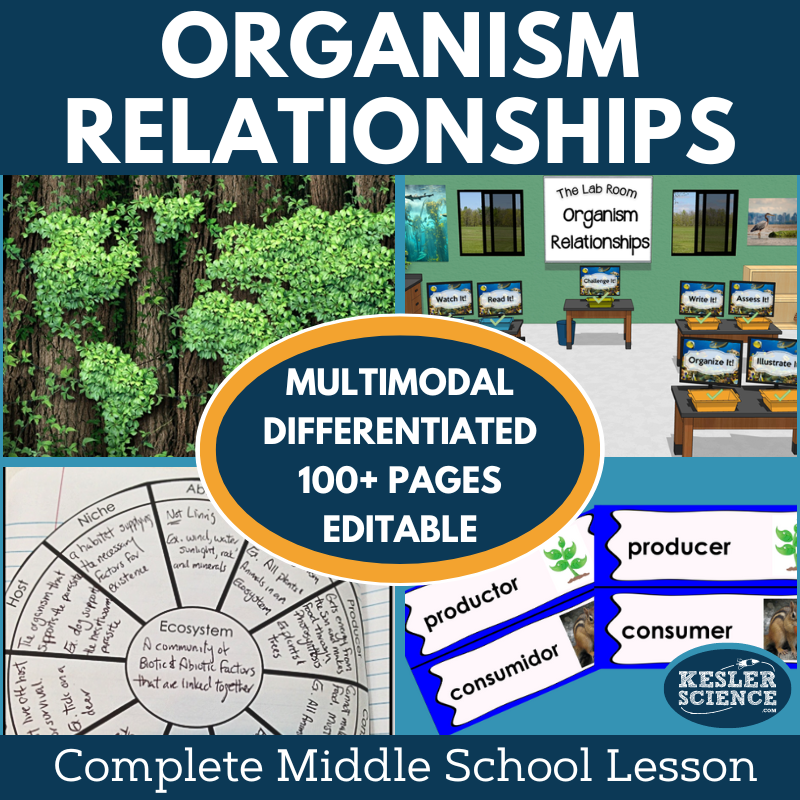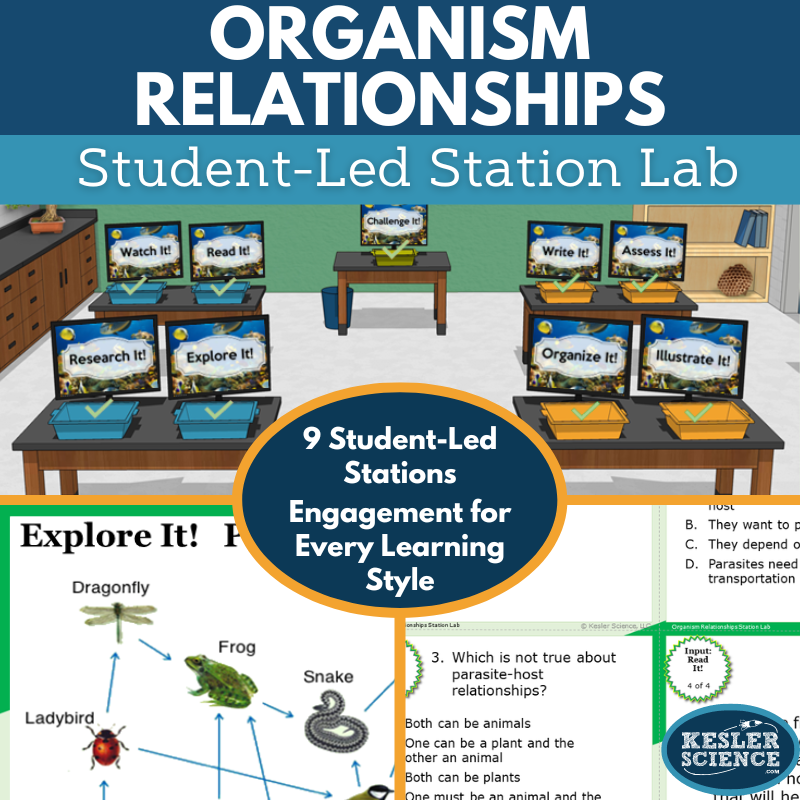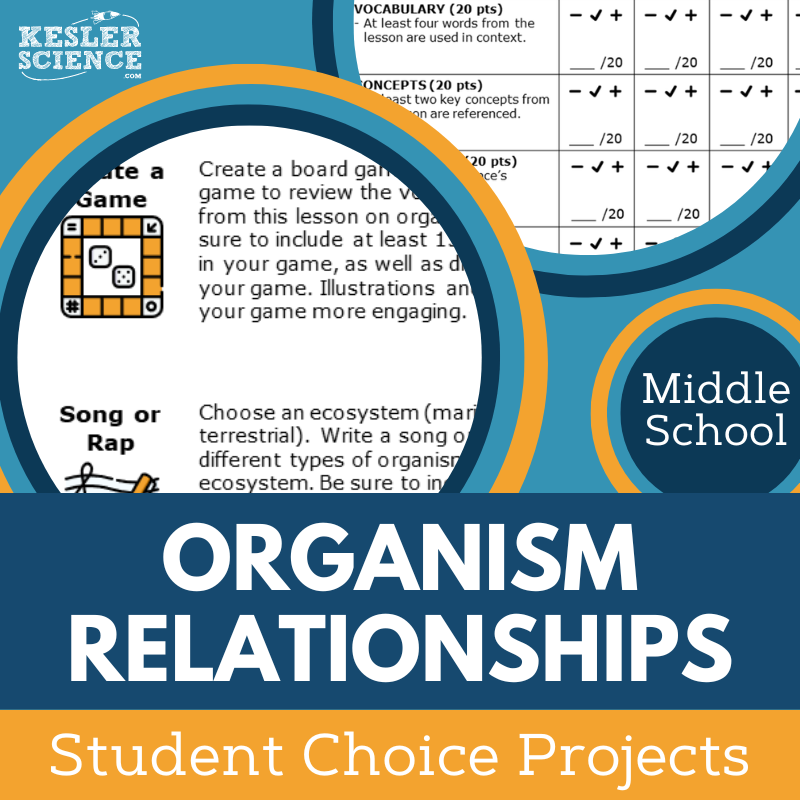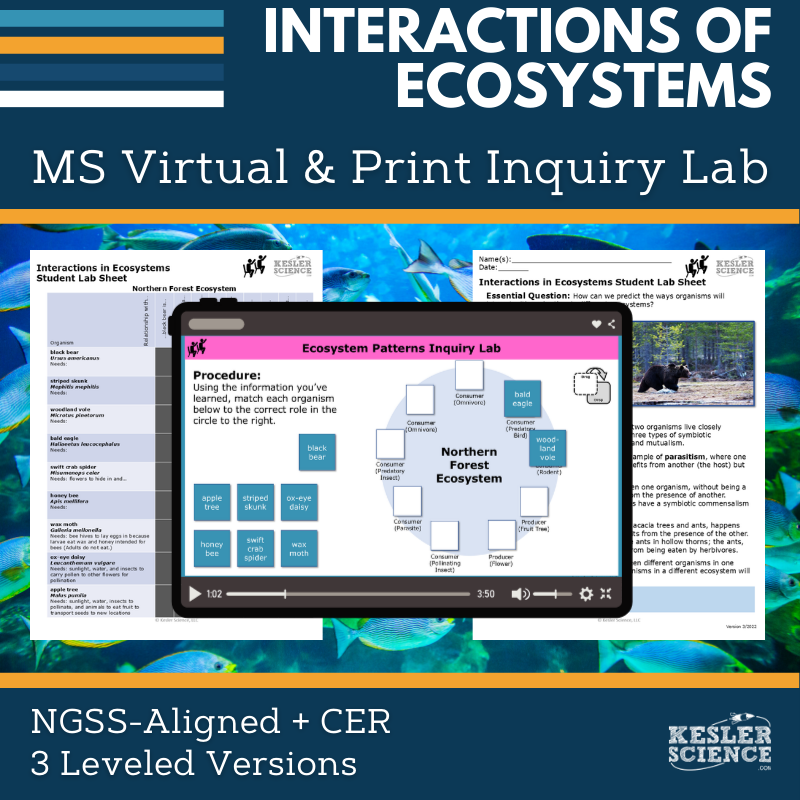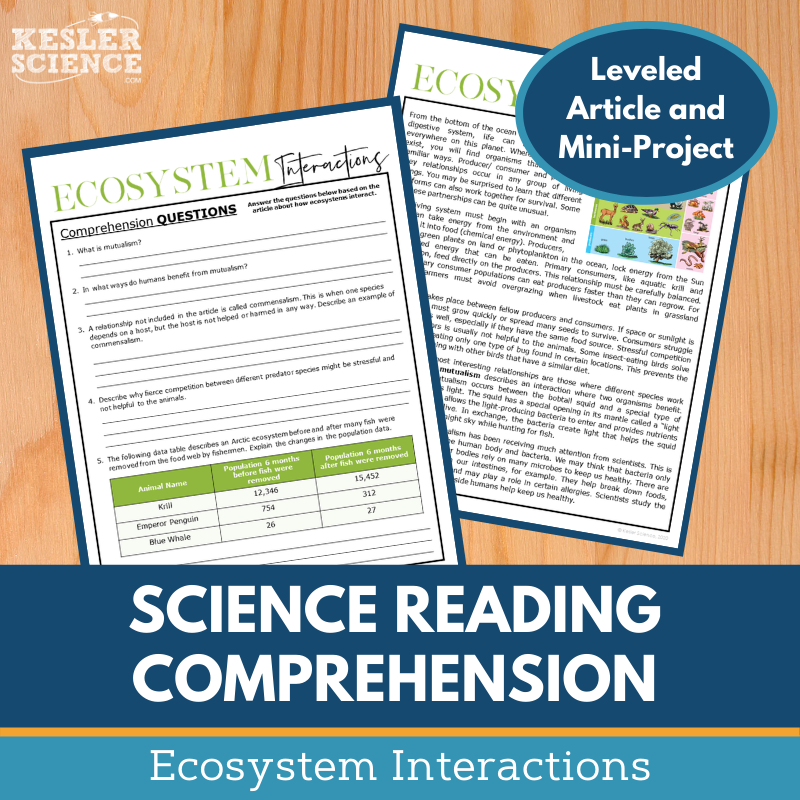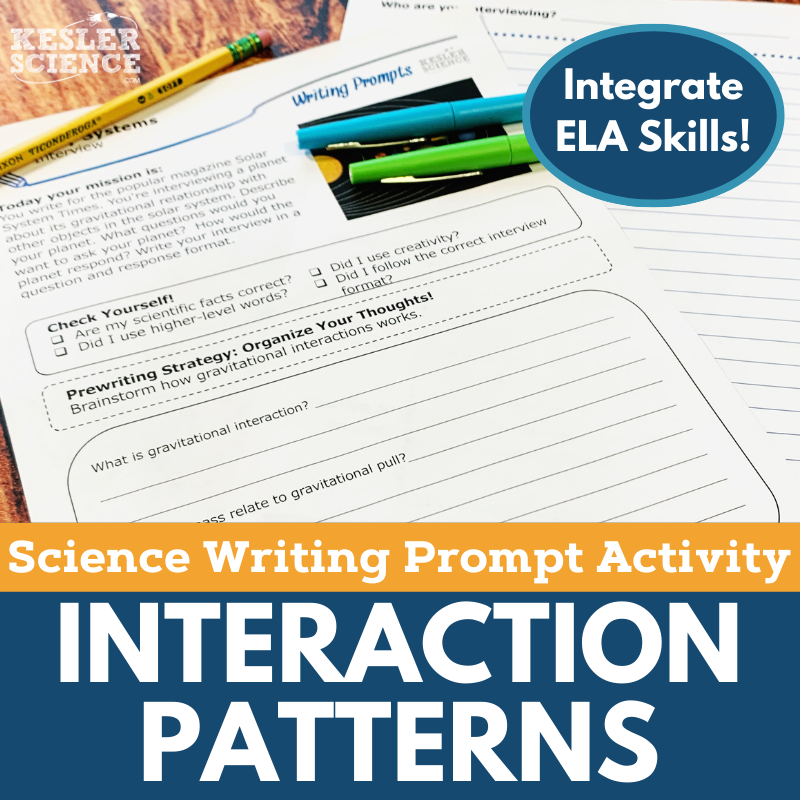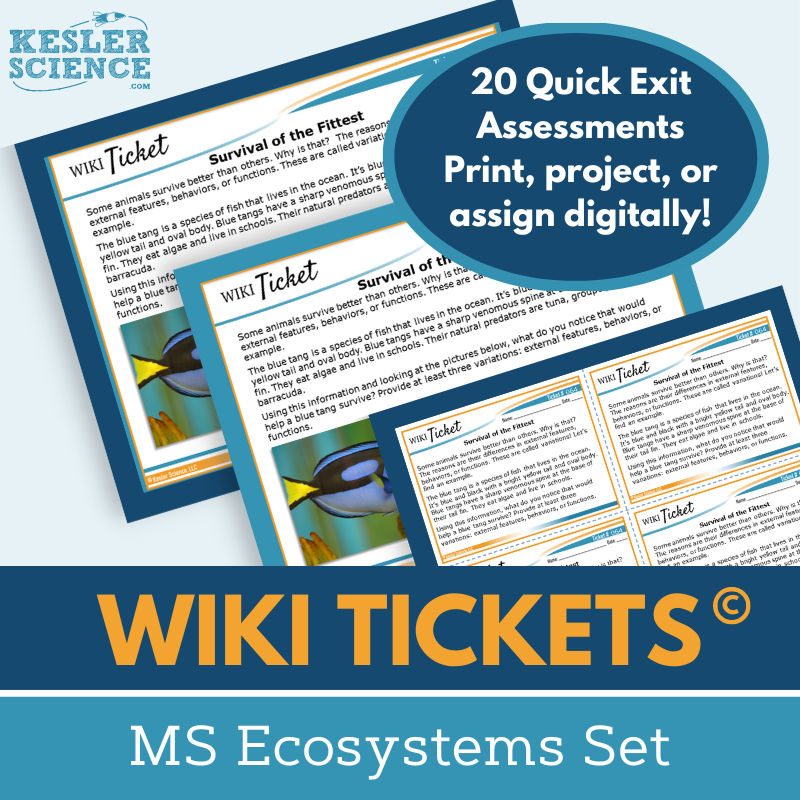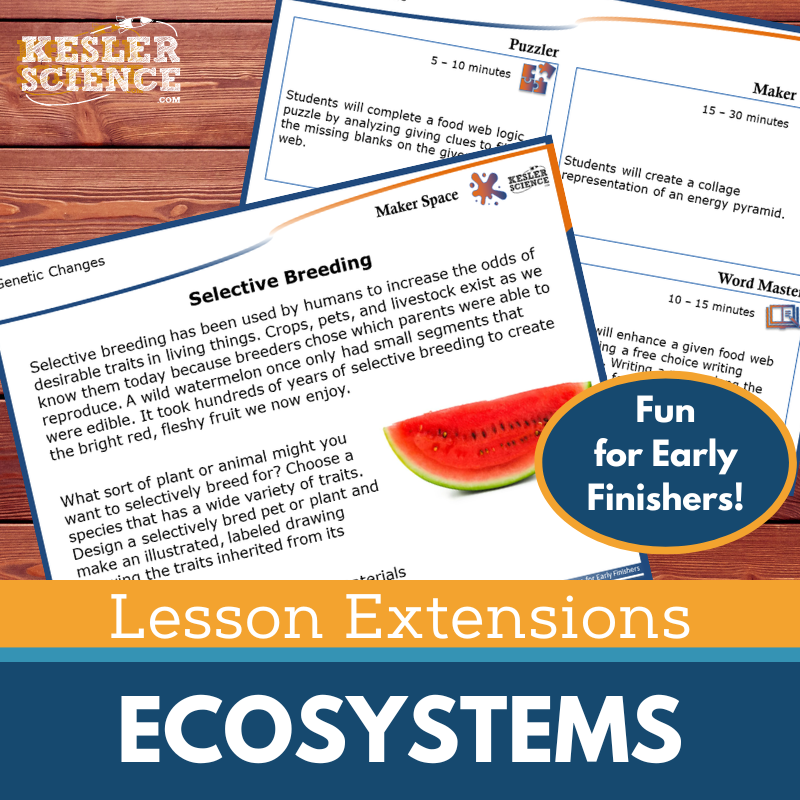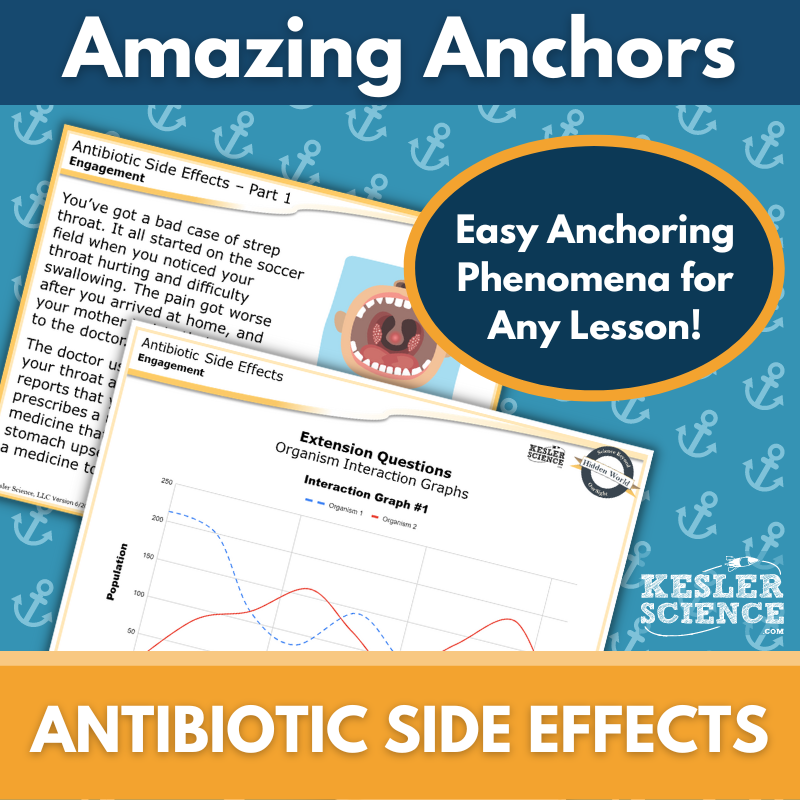Interactions in Ecosystems Activities for Middle School Science
Help students explore predator-prey, consumer-producer, and parasite-host relationships in marine, freshwater, and terrestrial ecosystems with this engaging 5E lesson. The resources below will give students a comprehensive understanding of interactions in ecosystems. All of the following materials are also included in the Kesler Science Membership.
The Kesler Science Organism Relationships 5E Lesson is a comprehensive, student-led unit covering predator/prey, consumer/producer, and parasite/host relationships in marine, freshwater, and terrestrial ecosystems. This fully editable, multiday lesson includes presentations, worksheets, choice projects, and assessments, requiring minimal prep while supporting differentiated learning.
Following the 5E Model, the unit engages students with objectives, word wall cards, and discussion activities. The hands-on station lab offers multimodal exploration through experiments, reading passages, videos, research tasks, and categorization exercises. Editable PowerPoints, interactive notebooks, and note-taking templates enhance explanation, while student-choice projects extend learning. Evaluation includes STAAR 2.0-aligned assessments and review materials.
Designed for flexibility, the lesson is available in printable and digital formats with Spanish translations for key materials. Suitable for both in-class and virtual learning, this resource ensures middle school students remain engaged while deepening their understanding of food web relationships.
The Kesler Science Organism Relationships 5E Lesson is a comprehensive, student-led unit covering predator/prey, consumer/producer, and parasite/host relationships in marine, freshwater, and terrestrial ecosystems. This fully editable, multiday lesson includes presentations, worksheets, choice projects, and assessments, requiring minimal prep while supporting differentiated learning.
Following the 5E Model, the unit engages students with objectives, word wall cards, and discussion activities. The hands-on station lab offers multimodal exploration through experiments, reading passages, videos, research tasks, and categorization exercises. Editable PowerPoints, interactive notebooks, and note-taking templates enhance explanation, while student-choice projects extend learning. Evaluation includes STAAR 2.0-aligned assessments and review materials.
Designed for flexibility, the lesson is available in printable and digital formats with Spanish translations for key materials. Suitable for both in-class and virtual learning, this resource ensures middle school students remain engaged while deepening their understanding of food web relationships.
Engage your middle school students with this student-led station lab on organism relationships, designed to promote active learning with minimal prep time. Through this interactive lesson, students will identify and compare characteristics of organism relationships while directing their own learning.
This modular station lab includes eight differentiated activities and a challenge station for early finishers. Students explore new concepts through hands-on demonstrations, research, readings, and videos. They demonstrate their understanding by organizing information, illustrating models, writing responses, and completing assessments.
All station materials, including signage, literature, resources, and task cards, are provided for independent or small-group work. The lesson is available for both in-class and virtual learning, ensuring flexibility for any teaching environment.
Engage your middle school students with this student-led station lab on organism relationships, designed to promote active learning with minimal prep time. Through this interactive lesson, students will identify and compare characteristics of organism relationships while directing their own learning.
This modular station lab includes eight differentiated activities and a challenge station for early finishers. Students explore new concepts through hands-on demonstrations, research, readings, and videos. They demonstrate their understanding by organizing information, illustrating models, writing responses, and completing assessments.
All station materials, including signage, literature, resources, and task cards, are provided for independent or small-group work. The lesson is available for both in-class and virtual learning, ensuring flexibility for any teaching environment.
The Organism Relationships Student Choice Projects provide middle school students with the opportunity to demonstrate their understanding of ecosystems in a way that aligns with their preferred learning style. The project page includes six structured student-led project options, along with a “design your own” choice, allowing for creativity and personalization. An editable rubric supports teacher, peer, or self-assessment, ensuring flexibility in grading and evaluation.
Designed for differentiation, the project includes two versions of the choice board. The modified version provides targeted support for students needing remediation, while advanced learners can take on a combination of projects for a greater challenge. This structure allows teachers to adapt the assignment to meet diverse classroom needs while maintaining consistency in assessment.
The projects require only basic classroom supplies such as paper, markers, and scissors, with many options available for digital completion. Some crafting materials may be helpful for students who choose to build models, adding a hands-on component to their learning experience. These multimodal projects encourage engagement, creativity, and deeper exploration of organism relationships within ecosystems.
The Organism Relationships Student Choice Projects provide middle school students with the opportunity to demonstrate their understanding of ecosystems in a way that aligns with their preferred learning style. The project page includes six structured student-led project options, along with a “design your own” choice, allowing for creativity and personalization. An editable rubric supports teacher, peer, or self-assessment, ensuring flexibility in grading and evaluation.
Designed for differentiation, the project includes two versions of the choice board. The modified version provides targeted support for students needing remediation, while advanced learners can take on a combination of projects for a greater challenge. This structure allows teachers to adapt the assignment to meet diverse classroom needs while maintaining consistency in assessment.
The projects require only basic classroom supplies such as paper, markers, and scissors, with many options available for digital completion. Some crafting materials may be helpful for students who choose to build models, adding a hands-on component to their learning experience. These multimodal projects encourage engagement, creativity, and deeper exploration of organism relationships within ecosystems.
The Interactions in Ecosystems Inquiry Lab aligns with NGSS MS-LS2-2, guiding students to construct explanations predicting patterns of interactions among organisms across multiple ecosystems. This lab offers both digital and hands-on print formats, allowing flexibility in implementation.
Students will research a northern forest ecosystem, compare organism roles, and analyze interactions to predict relationships in another ecosystem. Comprehension questions, Claim-Evidence-Reasoning (C.E.R.) prompts, and reflection sections support deeper understanding.
Three differentiated versions ensure accessibility for all learners: a dependent version with guided inquiry, a modified version with structured support, and an independent version for advanced students to lead their own investigations. The digital format is fully interactive and compatible with Google Slides, while the print format provides hands-on engagement.
Teacher resources include editable PowerPoints, answer keys, CER statements, reflection questions, and detailed lesson guides, ensuring a comprehensive and adaptable learning experience.
The Interactions in Ecosystems Inquiry Lab aligns with NGSS MS-LS2-2, guiding students to construct explanations predicting patterns of interactions among organisms across multiple ecosystems. This lab offers both digital and hands-on print formats, allowing flexibility in implementation.
Students will research a northern forest ecosystem, compare organism roles, and analyze interactions to predict relationships in another ecosystem. Comprehension questions, Claim-Evidence-Reasoning (C.E.R.) prompts, and reflection sections support deeper understanding.
Three differentiated versions ensure accessibility for all learners: a dependent version with guided inquiry, a modified version with structured support, and an independent version for advanced students to lead their own investigations. The digital format is fully interactive and compatible with Google Slides, while the print format provides hands-on engagement.
Teacher resources include editable PowerPoints, answer keys, CER statements, reflection questions, and detailed lesson guides, ensuring a comprehensive and adaptable learning experience.
This Science Reading Comprehension Lesson helps students explore patterns of interactions among organisms across multiple ecosystems. Through a nonfiction article, students examine how organisms work together to survive, then complete comprehension questions and create an ecosystem profile.
Designed for middle school (grades 6-8) and advanced 5th graders, the leveled passage (Lexile 1100-1300) supports science literacy and reading comprehension. The resource includes five to seven comprehension questions, a hands-on mini-project, and a Cornell notes template.
Perfect for sub plans, ISS, extra credit, or whole-class instruction, this resource fosters critical thinking, classroom discussions, and textual analysis. It is compatible with Google Classroom, MS Teams, Schoology, and Canvas, allowing students to complete activities digitally.
This Science Reading Comprehension Lesson helps students explore patterns of interactions among organisms across multiple ecosystems. Through a nonfiction article, students examine how organisms work together to survive, then complete comprehension questions and create an ecosystem profile.
Designed for middle school (grades 6-8) and advanced 5th graders, the leveled passage (Lexile 1100-1300) supports science literacy and reading comprehension. The resource includes five to seven comprehension questions, a hands-on mini-project, and a Cornell notes template.
Perfect for sub plans, ISS, extra credit, or whole-class instruction, this resource fosters critical thinking, classroom discussions, and textual analysis. It is compatible with Google Classroom, MS Teams, Schoology, and Canvas, allowing students to complete activities digitally.
The Interaction Patterns Science Writing Prompt Activity engages middle school students in journal-based exercises to reinforce their understanding of life science. Aligned with MS-LS2-2, this student-centered activity helps students construct explanations predicting interaction patterns among organisms across multiple ecosystems. Designed for both in-person and virtual learning, this low-prep resource enhances science reasoning and writing skills.
This activity includes teacher directions with an answer guide, project ideas, and rubrics, along with projection and print handouts in both full-sized and half-sheet formats. A digital interactive PowerPoint version, compatible with Google Slides, allows for flexible assignment options. Ideal for cross-curricular learning, pre-test assessments, student choice projects, early finisher activities, extra credit, make-up work, TELPAS samples, or differentiation exercises, this engaging writing prompt fosters creativity and comprehension. These activities can be displayed on a bulletin board or compiled into a student anthology. Note: This resource assumes prior knowledge of the topic or access to research materials.
The Interaction Patterns Science Writing Prompt Activity engages middle school students in journal-based exercises to reinforce their understanding of life science. Aligned with MS-LS2-2, this student-centered activity helps students construct explanations predicting interaction patterns among organisms across multiple ecosystems. Designed for both in-person and virtual learning, this low-prep resource enhances science reasoning and writing skills.
This activity includes teacher directions with an answer guide, project ideas, and rubrics, along with projection and print handouts in both full-sized and half-sheet formats. A digital interactive PowerPoint version, compatible with Google Slides, allows for flexible assignment options. Ideal for cross-curricular learning, pre-test assessments, student choice projects, early finisher activities, extra credit, make-up work, TELPAS samples, or differentiation exercises, this engaging writing prompt fosters creativity and comprehension. These activities can be displayed on a bulletin board or compiled into a student anthology. Note: This resource assumes prior knowledge of the topic or access to research materials.
These WIKI Tickets© Formative Assessments offer engaging, flexible ways to check student understanding of Ecosystems topics in 6th-8th grade science. The set includes 20 topics, each provided in five different formats: a full-screen projection version, three printable handouts (full-page, half-page, quarter-page), and an interactive digital version compatible with PowerPoint and Google Slides.
Aligned with middle school NGSS and TEKS standards, these versatile resources can serve as exit tickets, bellringers, or quick formative checks in both in-person and virtual classrooms. Topics include biodiversity, biotic and abiotic factors, taxonomy, ecological succession, food webs, human impacts, natural selection, photosynthesis, and environmental changes. A table of contents detailing standards alignment is included to help educators effectively track student progress.
These WIKI Tickets© Formative Assessments offer engaging, flexible ways to check student understanding of Ecosystems topics in 6th-8th grade science. The set includes 20 topics, each provided in five different formats: a full-screen projection version, three printable handouts (full-page, half-page, quarter-page), and an interactive digital version compatible with PowerPoint and Google Slides.
Aligned with middle school NGSS and TEKS standards, these versatile resources can serve as exit tickets, bellringers, or quick formative checks in both in-person and virtual classrooms. Topics include biodiversity, biotic and abiotic factors, taxonomy, ecological succession, food webs, human impacts, natural selection, photosynthesis, and environmental changes. A table of contents detailing standards alignment is included to help educators effectively track student progress.
Lesson Extensions offer engaging, student-choice activities specifically designed to challenge early finishers and deepen their understanding of ecosystems aligned with NGSS and TEKS standards. These extensions provide rigorous yet enjoyable learning opportunities ideal for lesson wrap-ups, downtime during testing, or preventing distractions by keeping students actively engaged.
Each extension includes four interactive components: Puzzler for developing problem-solving skills, Maker Space for hands-on STEAM activities, Tech Connection for digital media demonstrations, and Word Master for creative writing exercises related to science. The resources come with teacher directions, answer keys, and both digital projection and print versions (full- and half-sheet sizes) for classroom flexibility.
This bundle covers diverse ecosystem topics, including biodiversity, biomes, biotic and abiotic factors, ecological succession, food webs, human impact, photosynthesis, resource availability, and many more, supporting high-level enrichment and independent learning.
Lesson Extensions offer engaging, student-choice activities specifically designed to challenge early finishers and deepen their understanding of ecosystems aligned with NGSS and TEKS standards. These extensions provide rigorous yet enjoyable learning opportunities ideal for lesson wrap-ups, downtime during testing, or preventing distractions by keeping students actively engaged.
Each extension includes four interactive components: Puzzler for developing problem-solving skills, Maker Space for hands-on STEAM activities, Tech Connection for digital media demonstrations, and Word Master for creative writing exercises related to science. The resources come with teacher directions, answer keys, and both digital projection and print versions (full- and half-sheet sizes) for classroom flexibility.
This bundle covers diverse ecosystem topics, including biodiversity, biomes, biotic and abiotic factors, ecological succession, food webs, human impact, photosynthesis, resource availability, and many more, supporting high-level enrichment and independent learning.
This Amazing Anchors Phenomenon Lesson introduces and reinforces organism interactions through a real-world connection to antibiotics. The introductory reading engages students with the topic, followed by comprehension and extension questions to deepen understanding. The explanatory reading breaks down the science behind organism interactions, with additional questions to reinforce learning.
This NGSS-aligned, no-prep resource includes teacher directions, answer keys, projection slides, and both print and digital formats for Google Classroom and other LMS platforms. It offers full- and half-sheet handouts for interactive notebooks and an editable version for customization. A differentiated version provides sentence starters to support student comprehension. Designed to bookend a lesson, these engaging readings supplement any in-person or virtual classroom, fitting seamlessly into the Engagement and Elaborate segments of 5E lessons.
This Amazing Anchors Phenomenon Lesson introduces and reinforces organism interactions through a real-world connection to antibiotics. The introductory reading engages students with the topic, followed by comprehension and extension questions to deepen understanding. The explanatory reading breaks down the science behind organism interactions, with additional questions to reinforce learning.
This NGSS-aligned, no-prep resource includes teacher directions, answer keys, projection slides, and both print and digital formats for Google Classroom and other LMS platforms. It offers full- and half-sheet handouts for interactive notebooks and an editable version for customization. A differentiated version provides sentence starters to support student comprehension. Designed to bookend a lesson, these engaging readings supplement any in-person or virtual classroom, fitting seamlessly into the Engagement and Elaborate segments of 5E lessons.
Year-Round Resources
These year-round activities will increase your students' understanding of many middle school science topics. All of these activities are also included in the Kesler Science Membership.
Visual Data & Graphing
You're not alone if your students struggle with understanding graphs, charts, and tables. It's a skill that takes an enormous amount of practice. This resource will help students build a strong foundation in analyzing data and creating their own data visualizations.
Bell Ringers and Warm-Ups
These middle school science bell ringers are an excellent way to engage your students as soon as they walk into your classroom. This comprehensive FULL YEAR resource includes everything you need to start off each science class with an interesting warm-up activity.
Review Board Games
Each game board has been carefully designed to keep students engaged. There are 10 different action spaces on each board and dozens of question cards. All of the actions are related to science concepts and keep the students motivated throughout the game.
Each game is ready to play. Simply print out the board and the cards and let the students enjoy reviewing nine different units.
Essential Questions and Standards
Below are the essential questions and standards associated with the lessons and activities included in the interactions in ecosystems unit. This topic is only one of more than 100 middle school science topics included in the Kesler Science Membership.
-
Describe organisms’ relationships in a food web, including: predator/prey, consumer/producer, and parasite/host.
-
Describe organism relationships in marine, freshwater, and terrestrial ecosystems.
-
NGSS - MS-LS2-2 Interactions in Ecosystems
Kesler Science Membership
Imagine never having to search for another middle school science lesson again. The membership gives you access to ALL of the Kesler Science products in one place (Yes, including everything above).
Say goodbye to long hours of lesson prep.

